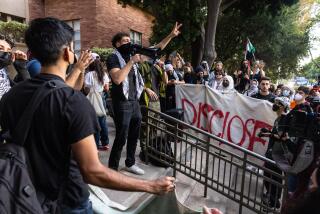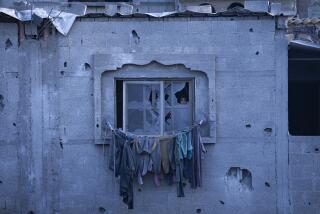Israeli-Palestinian conflict shifts ominously toward religious war
- Share via
Reporting from Jerusalem — Guarded by a phalanx of riot police, the knot of young Jewish men, long sidelocks blowing in the breeze, strode across the paved esplanade of Jerusalem’s most sensitive religious site. A group of veiled and black-robed Muslim women leaped up to confront them, rhythmically chanting: “Allahu akbar!” — “God is great!”
Scenes like this one, playing out recently on a windy hilltop in Jerusalem’s walled Old City, illustrate the antagonism that has long colored the Israeli-Palestinian conflict. Now, though, the overtly religious elements of what had long been primarily a national and territorial struggle appear to be coming to the fore.
In the Middle East, the term “holy war” sometimes serves as facile shorthand for events that are neither. In the last week, however, figures from Pope Francis to United Nations Secretary-General Ban Ki-moon have voiced alarm over the explicitly religious character of recent violence in Jerusalem and its environs.
That was crystallized this week by the horrific slaying of four Jewish worshipers in a Jerusalem synagogue and the killing of an Israeli police officer trying to defend them.
“The true danger … is that the wave of terror will turn into a true religious war, such as has not yet occurred here,” columnist Ben Caspit wrote this week in the Maariv newspaper. Many commentaries have noted the large potential for a conflict now primed to draw in Muslims not only in the Palestinian territories, but across the region and the Islamic world.
In Jerusalem, great religions have crowded and jostled their way down through millenniums. That is especially true in the walled Old City, where the trumpet-like sounding of the shofar, the wail of the muezzin and the pealing of church bells blend in a cacophony peculiar to this “port city on the shore of eternity,” as the late Israeli poet Yehuda Amichai put it.
Even before this week’s synagogue carnage in the Har Nof neighborhood of Jerusalem, there were growing signs that places of worship were becoming battlegrounds, including the torching this month of a mosque outside the West Bank city of Ramallah and a firebomb attack on a historic synagogue in northern Israel.
At the conflict’s heart, though, is the iconic Old City plateau revered by Jews as the Temple Mount and Muslims as the Noble Sanctuary. In recent weeks, it has served as the principal rallying cry for Palestinian attackers, its fate now driving the conflict just as surely as its familiar domes dominate the ancient skyline.
Many other factors have influenced the mutual acrimony of recent months: the June killings of three young Jewish seminary students in the West Bank, followed by the reprisal torture and killing of a Palestinian teen; the destructive summer war in the Gaza Strip; heavy-handed Israeli police tactics used to quell street unrest in traditionally Arab East Jerusalem. But no other single grievance has galvanized such passions as the contested holy site.
The biblical Mt. Moriah — site of the ancient Jewish temples and of Islam’s third-holiest venue, Al Aqsa mosque — has for the last half-century been governed by an arrangement known as the “status quo,” under which only Muslims are allowed to pray on the plateau. Jews, largely adhering to mainstream rabbinical injunctions against ascending the mount and perhaps inadvertently treading on the Holy of Holies — the inner sanctum where the Ark of the Covenant was once kept — prayed instead at the adjoining Western Wall.
For several months, though, a movement spearheaded by Jewish activists has surged to greater prominence, staging more frequent visits to the hilltop site, which at certain times is open to tourists. Followers were sometimes counseled on how to circumvent the prayer ban with tactics such as “accidentally” falling down in order to ritually prostrate oneself, or reciting prayer fragments as part of tourist-style observations about the site’s historic structures.
In the view of Palestinians, and of neighboring Jordan, the formal custodian of the site, Israeli Prime Minister Benjamin Netanyahu’s repeated pledges to retain the status quo were dubious, because some of those actively seeking to scrap the status quo were members of his own government, or of the Israeli parliament. On the Palestinian side, a concerted campaign of extremist rhetoric dismissed Jewish ties to the site, further galvanizing Jewish activists’ calls for greater access.
As Muslim fear of a physical division of the site intensified, punctuated by episodes of violent unrest on the plateau itself, Israel imposed age restrictions for Muslim men for Friday prayers, sometimes banning those younger than 50, sometimes those younger than 35. Young Palestinian men seethed — and prayed in the streets outside barricades guarded by Israeli riot police.
Against this backdrop, a Palestinian assailant late last month made a brazen bid to assassinate Israeli American activist Yehuda Glick, one of the most vocal advocates for expanded Jewish rights to the site. Though seriously wounded, Glick survived, and amid the ensuing turmoil, Israel closed the hilltop to all visitors for the first time in years, a step Palestinian Authority President Mahmoud Abbas called tantamount to a “declaration of war.”
Though the closure was brief, Jordan withdrew its ambassador in protest and warned that Israeli actions jeopardized their 2-decade-old peace treaty and a host of related accords. Secretary of State John F. Kerry made an urgent visit to Jordan this month for separate talks with Abbas and Netanyahu, winning promises of calming measures, including the lifting of the age restrictions for Friday prayers.
On Friday, midday prayers passed largely peacefully for the second week in a row, though with many hard-eyed glances between police officers and entering worshipers.
Rock-throwing clashes, which have become the near-daily norm in East Jerusalem neighborhoods, broke out later, and Palestinian protesters in the West Bank city of Hebron set an army post ablaze.
To many, the tilt toward a religion-centered conflict bodes ill for any revival of the peace process, which most recently broke down in April.
“So long as the conflict remains on a secular, territorial track, there remains hope of a solution — not so with religion,” analyst Uzi Rabi told Israel Radio. “This should be a wake-up call not only to Israel, but to world players.”
Despite a flurry of conciliatory interfaith gestures after the synagogue attack, including solidarity visits to the neighborhood by Muslim, Christian and other religious leaders, the dispute over the holy site appears on track to intensify, not ease.
A Tel Aviv University survey this month indicated that while a relatively slender majority of Israeli Jews — 56% — supported retaining the status quo, more than one-third wanted the prayer ban lifted, even if it resulted in bloodshed.
Columnist Nahum Barnea observed in the Yediot Aharonot newspaper that the shift from a national conflict to a religious one could unleash forces neither side could control.
“A thousand firefighters,” he wrote, “will not be able to extinguish a fire that has God as the fuse.”
Twitter: @laurakingLAT
Special correspondent Batsheva Sobelman contributed to this report.
More to Read
Sign up for Essential California
The most important California stories and recommendations in your inbox every morning.
You may occasionally receive promotional content from the Los Angeles Times.










